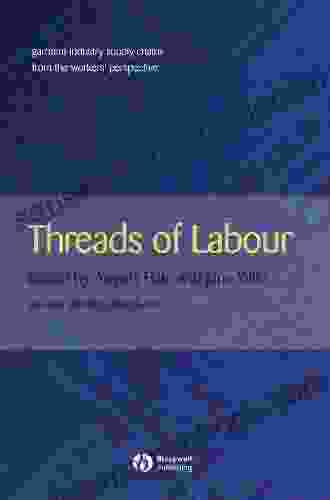Garment Industry Supply Chains: A Look from the Workers' Perspective

The garment industry is a vast and complex global network, involving millions of workers at every stage of the production process. From the cotton fields to the factories to the retail stores, workers play a vital role in producing the clothing that we wear.
5 out of 5
| Language | : | English |
| File size | : | 1869 KB |
| Text-to-Speech | : | Enabled |
| Screen Reader | : | Supported |
| Enhanced typesetting | : | Enabled |
| Word Wise | : | Enabled |
| Print length | : | 292 pages |
| Lending | : | Enabled |
However, the garment industry is also known for its poor working conditions, low wages, and lack of worker protections. Workers in the garment industry often face long hours, dangerous working conditions, and unfair treatment.
In this article, we will take a closer look at the garment industry supply chains from the workers' perspective. We will explore the challenges and opportunities that workers face, and highlight the need for change.
The Challenges Facing Garment Workers
Workers in the garment industry face a number of challenges, including:
- Low wages: Garment workers are often paid very low wages, which makes it difficult for them to support themselves and their families.
- Long hours: Garment workers often work long hours, often in excess of 60 hours per week.
- Dangerous working conditions: Garment factories are often unsafe, with poor ventilation, lighting, and safety equipment.
- Unfair treatment: Garment workers are often treated unfairly, with little respect for their rights as workers.
These challenges can have a devastating impact on the lives of garment workers. Low wages can lead to poverty, food insecurity, and lack of access to healthcare. Long hours can lead to fatigue, health problems, and burnout. Dangerous working conditions can lead to injuries, disabilities, and even death. Unfair treatment can lead to discrimination, harassment, and exploitation.
The Opportunities for Garment Workers
Despite the challenges they face, garment workers also have a number of opportunities to improve their lives and livelihoods. These opportunities include:
- Unionization: Garment workers can join unions to bargain for better wages, working conditions, and treatment.
- Training: Garment workers can receive training to improve their skills and earn higher wages.
- Cooperatives: Garment workers can form cooperatives to own and operate their own businesses.
- Fair trade: Garment workers can work with fair trade organizations to ensure that they are paid a fair wage and treated fairly.
These opportunities can help garment workers to improve their lives and livelihoods. Unions can help garment workers to negotiate for better wages, working conditions, and treatment. Training can help garment workers to improve their skills and earn higher wages. Cooperatives can help garment workers to own and operate their own businesses. Fair trade can help garment workers to ensure that they are paid a fair wage and treated fairly.
The Need for Change
The garment industry is in need of change. The current system is not sustainable, and it is not fair to the workers who produce our clothing. We need to create a more just and equitable garment industry, one that values workers and respects their rights.
There are a number of things that can be done to create a more just and equitable garment industry, including:
- Raise wages: Garment workers should be paid a living wage that allows them to support themselves and their families.
- Reduce hours: Garment workers should not be forced to work excessive hours. They should have the right to a reasonable work-life balance.
- Improve working conditions: Garment factories should be safe and healthy places to work. Workers should have access to clean air, adequate lighting, and safety equipment.
- Respect workers' rights: Garment workers should be treated with respect and dignity. They should have the right to freedom of association, collective bargaining, and a safe working environment.
By making these changes, we can create a more just and equitable garment industry. We can create an industry that values workers and respects their rights. We can create an industry that produces clothing that we can all be proud to wear.
The garment industry is a complex and global network, involving millions of workers at every stage of the production process. Workers in the garment industry face a number of challenges, including low wages, long hours, dangerous working conditions, and unfair treatment. However, workers also have a number of opportunities to improve their lives and livelihoods, including unionization, training, cooperatives, and fair trade. The garment industry is in need of change. We need to create a more just and equitable garment industry, one that values workers and respects their rights.
5 out of 5
| Language | : | English |
| File size | : | 1869 KB |
| Text-to-Speech | : | Enabled |
| Screen Reader | : | Supported |
| Enhanced typesetting | : | Enabled |
| Word Wise | : | Enabled |
| Print length | : | 292 pages |
| Lending | : | Enabled |
Do you want to contribute by writing guest posts on this blog?
Please contact us and send us a resume of previous articles that you have written.
 Top Book
Top Book Novel
Novel Fiction
Fiction Nonfiction
Nonfiction Literature
Literature Paperback
Paperback Hardcover
Hardcover E-book
E-book Audiobook
Audiobook Bestseller
Bestseller Classic
Classic Mystery
Mystery Thriller
Thriller Romance
Romance Fantasy
Fantasy Science Fiction
Science Fiction Biography
Biography Memoir
Memoir Autobiography
Autobiography Poetry
Poetry Drama
Drama Historical Fiction
Historical Fiction Self-help
Self-help Young Adult
Young Adult Childrens Books
Childrens Books Graphic Novel
Graphic Novel Anthology
Anthology Series
Series Encyclopedia
Encyclopedia Reference
Reference Guidebook
Guidebook Textbook
Textbook Workbook
Workbook Journal
Journal Diary
Diary Manuscript
Manuscript Folio
Folio Pulp Fiction
Pulp Fiction Short Stories
Short Stories Fairy Tales
Fairy Tales Fables
Fables Mythology
Mythology Philosophy
Philosophy Religion
Religion Spirituality
Spirituality Essays
Essays Critique
Critique Commentary
Commentary Glossary
Glossary Bibliography
Bibliography Index
Index Table of Contents
Table of Contents Preface
Preface Introduction
Introduction Foreword
Foreword Afterword
Afterword Appendices
Appendices Annotations
Annotations Footnotes
Footnotes Epilogue
Epilogue Prologue
Prologue Alice Aspinall
Alice Aspinall Christina Van Deventer
Christina Van Deventer Paul T Hellyer
Paul T Hellyer Mahauganee D Shaw Bonds
Mahauganee D Shaw Bonds Raes Calvert
Raes Calvert Sara Gay Forden
Sara Gay Forden Robert Kagan
Robert Kagan Anusree Roy
Anusree Roy Sierra Crane Murdoch
Sierra Crane Murdoch Clive Cussler
Clive Cussler Jeroen Mulder
Jeroen Mulder Stan Lee
Stan Lee Zoe Moore
Zoe Moore Soveressence
Soveressence M S Cross
M S Cross Jane Hirshfield
Jane Hirshfield Catherine Fisher
Catherine Fisher Richard Dotts
Richard Dotts Tammy Enz
Tammy Enz Arthur Winter
Arthur Winter
Light bulbAdvertise smarter! Our strategic ad space ensures maximum exposure. Reserve your spot today!

 Israel BellUnveiling the Enchanting World of Hello World Music: An Interview with Jill...
Israel BellUnveiling the Enchanting World of Hello World Music: An Interview with Jill... Calvin FisherFollow ·7.3k
Calvin FisherFollow ·7.3k Joseph ConradFollow ·10.3k
Joseph ConradFollow ·10.3k Jessie CoxFollow ·3.2k
Jessie CoxFollow ·3.2k Grayson BellFollow ·13.4k
Grayson BellFollow ·13.4k Tim ReedFollow ·11.1k
Tim ReedFollow ·11.1k Christian CarterFollow ·6.7k
Christian CarterFollow ·6.7k Jackson HayesFollow ·18.6k
Jackson HayesFollow ·18.6k José MartíFollow ·18k
José MartíFollow ·18k

 David Mitchell
David MitchellMy Surly Heart: Poetic Expressions of Unrequited Love...
In the annals of...

 Jake Carter
Jake CarterBleach Vol. 50: The Six Fullbringers - A Comprehensive...
Bleach Vol. 50, titled "The Six...

 Edward Reed
Edward ReedThe Art of Simple Food II: A Masterclass in Culinary...
In an era of culinary excess, where meals...

 Jarrett Blair
Jarrett BlairThe Easy Ingredient Ketogenic Diet Cookbook: Your Gateway...
The ketogenic diet,...

 Larry Reed
Larry ReedThe Very Edge Poems Polly Alice Mccann: A Poetic...
An to 'The Very...

 Sidney Cox
Sidney CoxThe Keys of Death and Hades: Unlocking the Epic of...
In the realm of mythology...
5 out of 5
| Language | : | English |
| File size | : | 1869 KB |
| Text-to-Speech | : | Enabled |
| Screen Reader | : | Supported |
| Enhanced typesetting | : | Enabled |
| Word Wise | : | Enabled |
| Print length | : | 292 pages |
| Lending | : | Enabled |










